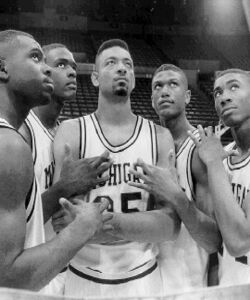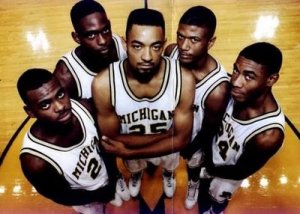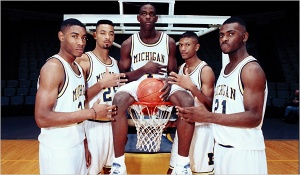In his book, Presentation Zen, presentation guru Garr Reynolds writes about how to give an intriguing presentation. When it comes to looking for inspiration, Reynolds thinks its important to go beyond simply reading. He cites documentaries as a source for inspiration in an oral presentation.
“Documentary films, for example, are a medium that tells a non-fiction story incorporating narration, interviews, audio, powerful video and still images, and at times, on-screen text. These are elements that can be incorporated into a live oral presentation as well.”
In order to gain some insight into Reynold’s theory, I decided to do a little investigating by watching a documentary completely unrelated to communications or presenting. Instead, I chose to watch a documentary on a topic I love, and one that is particularly relevant during the month of March: college basketball.
The Fab Five is a 2011 ESPN Films documentary about the 1991 University of Michigan men’s basketball recruiting class, which earned the nickname the “Fab Five”. Considered by many to be the greatest class ever recruited, Chris Webber, Jalen Rose, Juwan Howard, Jimmy King, and Ray Jackson, changed the face of college basketball forever. The film chronicles the recruitment, glory years, cultural impact, and scandal that followed these players who at the time were presented by the media as the embodiment of what was wrong with college sports. They revolutionized college basketball by wearing black socks, baggy shorts, listening to hip-hop music and talking trash to their competitors.
The film is brutally honest. The players look back on their mistakes, the way they were represented by the media, and their times of doubt. This makes The Fab Five that much more enjoyable. Its easy to think of basketball superstars as a different breed of people, untouched by the problems the rest of the world faces, but Director Jason Hehir shows just how real the Fab Five was.

“Trash talking was 100% of who I was, on every level. I would do research on people, and say nasty things to them based on that research. I was a student of trash talking.” – Jalen Rose
In the film, Hehir uses many elements of story telling, but what really drew me in was the connection I felt to the players. Throughout the film, I felt like I really got to know the Fab Five. Many of these players came from nothing and had one goal: to win. By using photographs and clips of the players from the 1990s and in-depth interviews with them today, Hehir was able to show how likable the team was. They were funny, driven, and most importantly, they HATED Duke. These characteristics had me rooting for Michigan throughout the film. I was mad when they read the racist hate letters sent to them by Michigan alumni, I was mad when they lost to Duke in the 1991 NCAA championship, and I actually felt bad for them when they lost to my own school, The University of North Carolina, in the 1992 NCAA Championship game on the accidental call of a time out. Seeing where the Fab Five came from, how badly they wanted it, and how badly they still wish they had won it, really pulled at my heartstrings.

“I’d rather be the Fab Five losing two straight championships than the Fab Five at home cooking fries and watching them on TV.” – Jalen Rose
What I learned from this film about the art of presenting is simple. Play on the audience’s emotions. If you can draw them in by making them feel something, you have succeeded. By playing on my emotions, The Fab Five captivated me for 97 minutes. I can only imagine how effective doing so would be for a 10-minute presentation.
